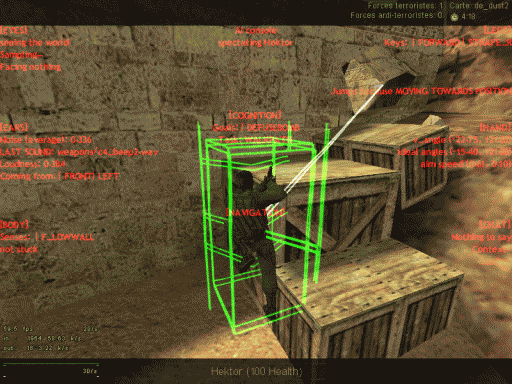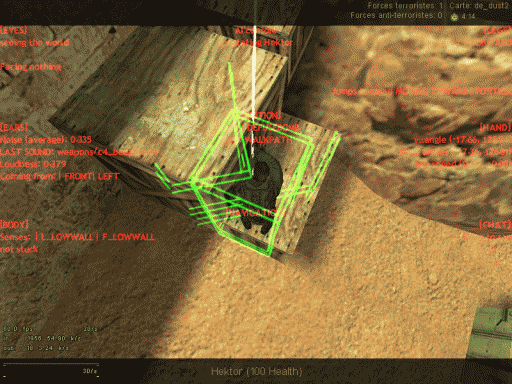 |
| filebase | forums | discord | server | github | wiki | web |
| cubebot | epodbot | fritzbot | gravebot | grogbot | hpbbot | ivpbot | jkbotti | joebot |
| meanmod | podbotmm | racc | rcbot | realbot | sandbot | shrikebot | soulfathermaps | yapb |
Re: development screenies |

|
|
(#71)
|
|
|
Roi de France
Status: Offline
Posts: 5,049
Join Date: Nov 2003
Location: 46°43'60N 0°43'0W 0.187A
|
Here are 2 other pics
They show how the collision detection works  The lateral and front traces lengths are function of the bot's velocity. For example, if the bot is strafing left, it will care more about obstacles on its left and little for those on its right, hence the left traces will be fired further than the right traces which will be clamped to the minimum.  here it's the same bot a few seconds later, but seen from the top. Perhaps it's more explicit. You can notably notice here how the bounding boxes (the boxes used by the engine for collision checking) of any entity in Half-Life are always axial, i.e, parallel to the map axises, no matter the direction the entity is facing. The bot's bounding box is the big green parallelogram. The three traces per side return different values which are interpreted as: wall (blocking), low wall (jump), low ceiling (duck), fall. The bot fills then an integer bitmap describing the quality of its surroundings for each of these three sides. On the second pic for example, you can see in the [body] section of the AI console that the bot senses a low wall on its left, and a low wall in front of it. It can then decide to jump over it. RACC home - Bots-United: beer, babies & bots (especially the latter) "Learn to think by yourself, else others will do it for you." |
|
|

|
Re: development screenies |

|
|
(#72)
|
|
|
Waypointer/Moderator
Status: Offline
Posts: 1,184
Join Date: Jan 2004
Location: Canada.. EH!?
|
Heyyo,
Man tha's cool how it can detect height, obstacles, and how to overcome them.  I have a small question aboot your bot. We've heard the new style that RACCbot navigates, but how's the combat? is it improved? or is it still running off the good ol' RACC style that was also implemented in the PODaim fix? |
|
|

|
Re: development screenies |

|
|
(#73)
|
|
|
Roi de France
Status: Offline
Posts: 5,049
Join Date: Nov 2003
Location: 46°43'60N 0°43'0W 0.187A
|
there is no combat code at all in this bot yet (hmm, it's not quite exact: there is still the old combat code from the old RACC but it's been all commented out). I have several ideas for that but I won't activate any combat code as long as the bots don't move at least as good as the CSbot and don't know how to do leapfrogging correctly.
Hence you can understand it's way too early to talk about a release... RACC home - Bots-United: beer, babies & bots (especially the latter) "Learn to think by yourself, else others will do it for you." |
|
|

|
Re: development screenies |

|
|
(#74)
|
|
|
RealBot Author
Status: Offline
Posts: 3,088
Join Date: Nov 2003
Location: Netherlands
|
very , very nice stuff there. It looks like cs bot to me
 I really have to investigate this mesh stuff some time , and replace the entire rb nav with it I really have to investigate this mesh stuff some time , and replace the entire rb nav with it  |
|
|

|
Re: development screenies |

|
|
(#75)
|
|
|
Member
Status: Offline
Posts: 512
Join Date: Feb 2004
Location: STL MO USA
|
The biggest problem with csbots combat mode is that they seem to completely ignore their nav areas and head straight for the ememy player. This causes big problems on alot of custom maps where you can fall to your death. Also, csbot doesn't know what water is yet, or how to navigate it. They made walls behind the ladders in the new maps because they were having problems with free-standing ladders and the bots trying to climb up the wrong side. Also still waiting on button usage too. new cz maps were also updated "for the bots" ie de_prodigy's button door is now an automatic opening door. Hopefully you can create a better combat code for RACC!
CSCZFiles: http://www.csczfiles.com/ CSBot nav tutorial: http://www.csczfiles.com/file.stuff?body=navtutorial |
|
|

|
Re: development screenies |

|
|
(#76)
|
|
|
Summoner
Status: Offline
Posts: 1,499
Join Date: Feb 2004
Location: Mist Village
|
IMHO Michael Booth's bot isn't very good... for example, it just used UTIL_TraceLine() to check if a place is in the same 'area'...and it will go pass the func_illusionary (such a st*p*d bug)
 |
|
|

|
Re: development screenies |

|
|
(#77)
|
|
|
RealBot Author
Status: Offline
Posts: 3,088
Join Date: Nov 2003
Location: Netherlands
|
thats a pitty because i expected button usage at least for an official bot... now they (valve/gearbox/turtle rock) just move the problem. THey do not fix the bots to open doors, they fix the doors for bots... blegh!
|
|
|

|
Re: development screenies |

|
|
(#78)
|
||
|
Member
Status: Offline
Posts: 594
Join Date: Mar 2004
Location: Middle Earth (New Zealand)
|
Quote:
if u can get the bot to detect the darkenss or how light it's curennt pos is u could use it to change the colour of the console...so say the bot is in the tunnels ..it detects a darkness of 7 level looks up a table for colour console based on a 1-10 scale for 7 giving a value red for the colour the console should be displayed in...this way rather than havaing the spectator cycling through the colours it get done automatically.  |
|
|
|

|
Re: development screenies |

|
|
(#79)
|
|
|
<-- He did it.
Status: Offline
Posts: 1,558
Join Date: Jan 2004
Location: Los Angeles, California, USA, North America, Earth, Solar System, Milky Way.
|
it's probably not possible unless he put the quake engine into his bot and read the bsp to get all the lighting and everything and get where all the dark places are or something like that...
|
|
|

|
Re: development screenies |

|
|
(#80)
|
||
|
Member
Status: Offline
Posts: 594
Join Date: Mar 2004
Location: Middle Earth (New Zealand)
|
Quote:
|
|
|
|

|
 |
«
Previous Thread
|
Next Thread
»
| Currently Active Users Viewing This Thread: 2 (0 members and 2 guests) | |
|
|
Powered by vBulletin® Version 3.8.2
Copyright ©2000 - 2024, Jelsoft Enterprises Ltd.
vBulletin Skin developed by: vBStyles.com
Copyright ©2000 - 2024, Jelsoft Enterprises Ltd.
vBulletin Skin developed by: vBStyles.com


 Autonomous fragmachines by PMB
Autonomous fragmachines by PMB 
















